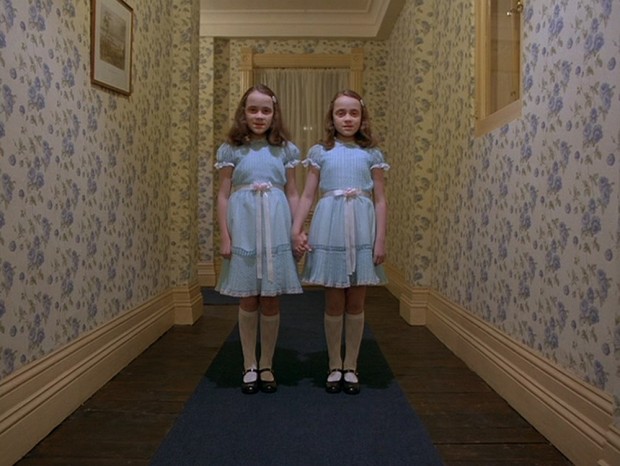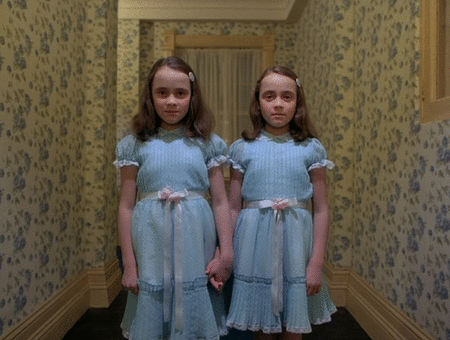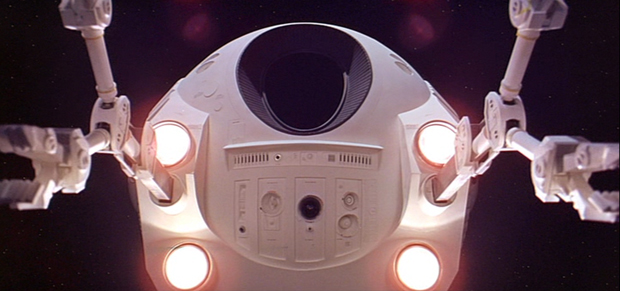STANLEY KUBRICK'S THE SHINING
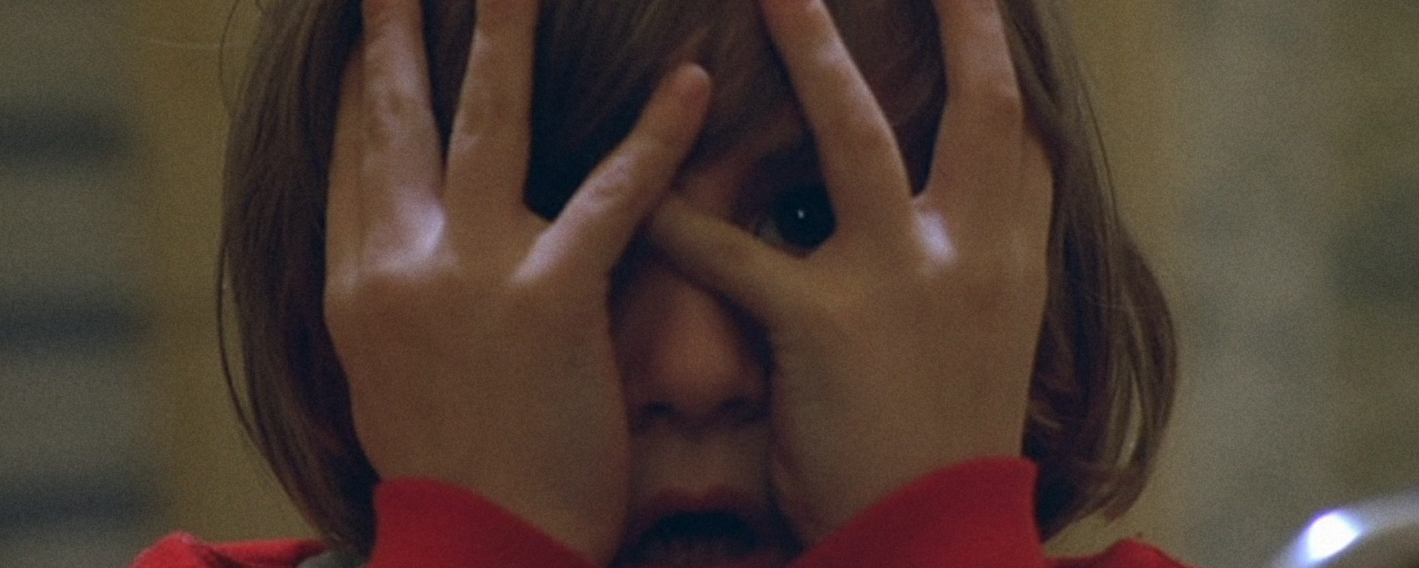
Go to TOC for this film ( (which has also a statement on purpose and manner of analysis and a disclaimer as to caveat emptor and my knowing anything authoritatively, which I do not, but I do try to not know earnestly, with some discretion, and considerable thought).
SATURDAY
After the travails on the mountaintop end, in the Lifetime version, Wendy and the Forest Ranger are going to absolutely get together
TOC and Supplemental Posts | Part 1 - The First Ascent | Part 2 - The Interview | Part 3 - Closing Day |
Part 4 - A Month Later | Part 5 - Tuesday | Part 6 - Thursday | Part 7 - Saturday | Part 8 - Monday |
Part 9 - Wednesday Part One | Part 10 - Wednesday Part Two | Part 11 - 8 AM | Part 12 - 4 PM |
Films Home
LINKS TO SECTIONS OF THE ANALYSIS ON THIS PAGE:
The Wires Go Down, Shots 212 through 226
White-out and Jack in the Colorado Lounge. Jack's new rule and the snowstorm.
Lines down, the Lodge Cut Off From the Outside World. Word play around ice cream and its relationship to CRM-114. The hotel and the emphasis on cleanliness.
The Radio Call to the Forest Rangerss. On flags and maps. The last of the "sha" sounds.
Danny's Final Vision of the "Twins", Shots 225 through 245
The Mirror Flip of the Times frm 11:40 to 6:10.. The open cabinet opposite the time cards foreshadows the cabinet in which Danny will later hide. Danny confronted by the shining of the murder of the girls. The ceiling lamps of the staff area. The peculiar double knob suspended in space. Dominant and recessive aspects.
Comparison With 2001
The Poster and the Girls. On the dominant and recessive aspects of the visions of the girls.
Call Us
As Above, So Below. Jacob's ladder and the Sabbath. On cycles represented in ShV and KDK.
Retiring the Big Wheel
In Review, What Has Kubrick Given Us in This Section?
What's the teaser candy bait?
What's the distraction?
What's the food for thought
What's the deep infrastructure?
THE WIRES GO DOWN
WHITE-OUT AND JACK IN THE COLORADO LOUNGE, JACK'S NEW RULE AND THE SNOWSTORM
212 Title shot. Saturday. (46:51)
213 LS exterior lodge. (46:54)
Open with an exterior shot of the hotel in white out conditions. We see no lights. The mountain is not viewed beyond, nor will it be viewed again, in accordance with Tuesday's superimposition of Wendy's operation of the can opener over the mountain, which made it appear as if she was cutting the top of the mountain away.
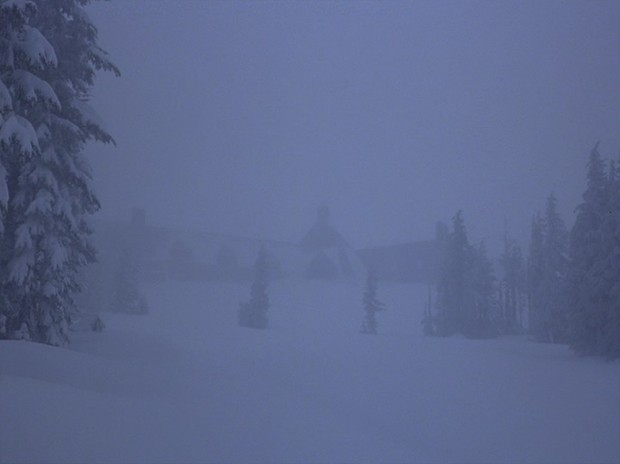
Fig. 1 - The lodge on Saturday, dark, showing no lights
214 LS Jack in Colorado lounge. (46:59)
Though we'd seen no lights from outside, the Colorado Lounge is lit. We view from above, from the second floor next the grand staircase, Jack typing away in the Colorado Lounge with its grand piano and a fire blazing in the fire place. Thursday had ended with Jack in the lounge, so Kubrick, returning to Jack, establishes a sense of emotional sameness while also showing us that Jack is alone as per his new rule. But it isn't an intimate shot, so distant that we get no new character information from it of Jack. All that we know is he is working and isolated.
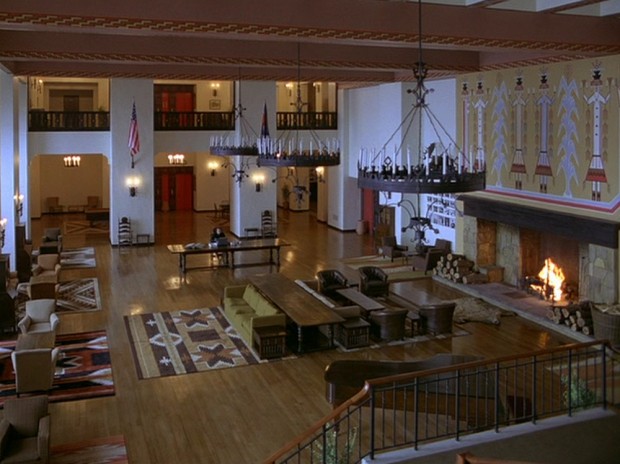
Fig. 2 - Jack types in the Colorado Lounge
When we reflect on the happenings of the previous Tuesday, Jack's demand for privacy, the new rule of no one entering the Colorado Lounge when he's at work in it, is not isolated from the larger story of the lodge and the snow storm that has shut it off from the outside world. These events work in tandem.
LINES DOWN, THE LODGE CUT OFF FROM THE OUTSIDE WORLD - WORD PLAY AROUND ICE CREAM AND ITS RELATIONSHIP TO CRM-114 - THE HOTEL AND THE EMPHASIS ON CLEANLINESS
215 MS Wendy. (47:09)
Cut to Wendy in moccasins and a yellow jacket decorated with images such as cactus and teepees, iconography of the desert west that links her again with the aboriginal, original aspect of the place, that the lodge was built on something which had existed prior.
All real physical action in the lodge as far as the meeting of daily responsibilities is embodied in Wendy. She takes care of the family. She takes care of the lodge. Danny plays. Jack is holed up with his typewriter. Confronting the real world is Wendy's domain so as the storm overwhelms them Wendy is the one to respond to the situation and communicate with the outside world.
This is our first view of the switchboard room. She's attempting to make a call, but the phone lines are out. A case full of phone books is behind her. Beside the switchboard, on the right, is a bulletin board that has emergency police numbers and fire information, an open envelope pinned to it, and a small card that reads EYE SCREAM. All these numbers and all of them useless without a line out of the lodge.
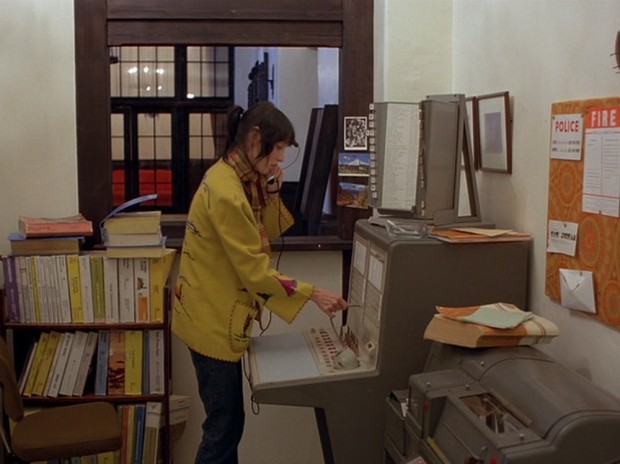
Fig. 3 - Unable to make a connection, Wendy discovers the phone lines are down
We see above the bulletin board a good luck horse shoe. One thing this does is perhaps take us back to the Boulder apartment and the painting of the horse racing down the tracks toward the train, which we saw on the wall after Danny's collapse from his vision and his visit with the doctor. Danny is about to see the two girls again.
A horse shoe featured in The Killing, intended to bring good luck but it instead meant the death of the killer the racing horse, Red Lightning. That killing of the horse was to serve as a distraction from a major heist.
There is a sleeping individual in a sombrero on her jacket. This takes me back to both a screen and a print in Lolita. In the upstairs hallway of the Haze household there was what appeared to be a screen, painted with a man in sombrero. At the opposite end of the hall was a painting with a seated woman holding her curled hands over her eyes, as if she had been crying. The crying woman forecast Humbert's later crying when he met the married Lolita and she refused to leave with him. The figure with the sombrero was duplicated exactly in miniature on a print in Lolita's room. Those things with the Mexican images were likely mementos of Charlotte's honeymoon trip to Mexico.
The lodge closed on October 30th, and the Eye Scream perhaps has to do with Halloween festivities before then. But Eye Scream also brings to mind Dick having offered Danny ice cream on the closing day, as in eye scream equals ice cream. When Danny had heard Dick ask if he liked ice cream, it was when Dick was talking to Wendy about the supplies in the "story" room, so that in a sense we had already a dual language. Dick was saying one thing to Wendy and Danny was hearing another, but the audience didn't hear what exactly Dick was saying to Wendy at the moment of the shining as his speaking voice was obscured by a voice over. The layering of language and communication suits well the numerous doublings in the Lontano music thet continues to play here, which had also played in the Thursday section.
When Danny had heard Doc say "ice cream", Doc had been standing before canisters of Calumet baking powder decorated with the American Indian in feathered headdress, and here we have Wendy in the jacket with American Indian images.
In Rememberance and Repetition in Kubrick's "The Shining" I propose a meaning for the curious CRM-114 that is found in different formations in Kubrick's films. In Doctor Strangelove, the CRM-114 radio equipment of a military jet is damaged so that it is unable to receive a recall code that would stop the crew from continuing its mission to drop a nuclear warhead on Russia. In A Clockwork Orange, Alex is separated out to be given the treatment that will make him into the "perfect Christian", which involves the injection of Serum-114. When Alex is told he's lucky to have been chosen, as the word "chosen" is said the camera zooms in on Serum 114. Because of this, I have reasoned it is likely that CRM and Serum are a variation of the Hebrew word ChRM, which means "chosen", secluded, devoted to religious purposes. This may not have been the intent of the author of Red Alert, but I think it's what Kubrick saw in CRM.
ChRM (herem) is a peculiar word and there's some debate on its exact meaning. Often it is used for things purposed for destruction--not as a matter of personal vendetta but as a dedication to god as commanded by god, as in a ritualized killing, that thing thus marked apart as belonging to god.
Rabbi Howard Cohen writes of "herem":
The second half of Leviticus 27:28 states that "...every proscribed thing is totally consecrated (alternatively, is considered to be super holy) to the Lord". Since something that is "tamei" (ritually unclean) must be set aside, that is put into a kind of temporary "herem", for varying lengths of time and must not come into contact with things or people who are deemed "tahor" (ritually clean) or "kadosh" (holy) it is hard to understand why the Torah describes something proscribed as also super holy ("kodesh-kodeshim"). Moreover, both "herem" and "kodosh" have essentially the same meaning: something set aside for specific purposes associated with the temple, property (so to speak) of God. How is it that something which is "herem"- proscribed can also be "kodesh-kodeshim - holiest of holies? Rabbi David Kraemer offers a brilliant insight into understanding this problem. Both "herem" and "kadosh" mean set aside for God. The difference, Kraemer argues, is that things which are proscribed are completely cut off from human access while things which are 'kodesh' have limited access. In other words, "herem" is like "kodosh" only more so, hence the reason why Leviticus 27:28 conflates "herem" with "kodosh-kodeshim".
In Islam, the sacred black stone Kaaba resides in the holy house called Masjid al-Haram. Haram can mean an inviolate zone as in a sanctuary, or something which is impure, forbidden.
Keeping in mind the above, a different light may be shed on the many notices at the hotel emphasizing cleanliness, using the appropriate bins for litter, and Wendy's game with Danny as they ran into the maze, she saying the loser would get the job of keeping America clean, the litter bins about the grounds of the hotel decorated with "Keep America Clean" posters.
In Eyes Wide Shut CRM 114 is supposedly formed by appearing as the C-Wing, room 14, the morgue where Bill sees Amanda's body--at least that is what I've read but I've personally never seen 14 connected with the morgue.
However, we do have, in that film, the woman in the black mask offering himself up to redeem Bill at the party.
Going to Leviticus 27 we see:
Notwithstanding, no devoted thing, that a man may devote unto the Lord of all that he hath, whether of man or beast, or of the field of his possession, shall be sold or redeemed; every devoted thing is most holy unto the Lord. None devoted, that may be devoted of men, shall be ransomed; he shall surely be put to death.
Thus we have Bill asking, in Eyes Wide Shut, "How is this woman to redeem me...I can't let this woman pay for me." And the answer being he can't change her fate, that when a promise has been made there is no turning back.
My idea is that CRM-114 and Serum 114 are the same as ChRM, and that we may find it in "ice cream" in The Shining. If one is looking for the 114, it will show up as soon as Wendy goes and calls the forest ranger. His clock will read 11:40. 411 is also the number for director assistance, and we have Wendy who is trying to call out at the switchboard but is unable to do so, for which reason she goes in to try the radio.

Fig. 4 - Wendy turns to exit the switchboard room for the lobby, giving us a good front view of her jacket
We see on Wendy's jacket pockets two cacti. They are in the shape of the number 4.
As Wendy leaves we see the back of her jacket. The cactus that appears on the pockets on the front has been reversed (befitting the cactus now being on the back of her jacket) and a person in a sombrero is taking a siesta against it. Ow. Seems like that would hurt, taking a nap next a saguaro cactus. What has Danny said shining is like to him? He told Dick it was like sleep. When he wakes up he doesn't remember everything.
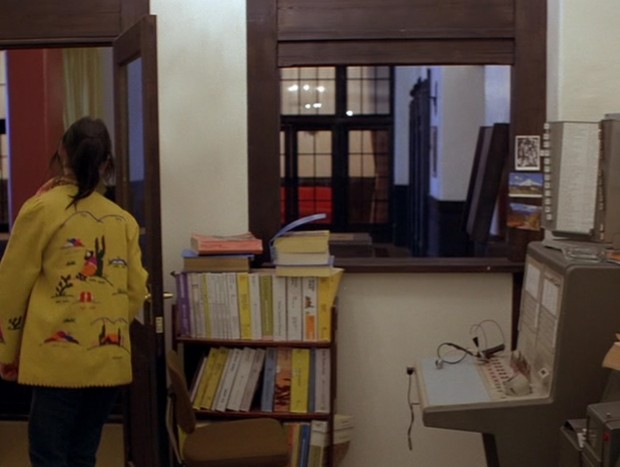
Fig. 5 - Entering the lobby, we are given a full glance at Wendy's jacket.
THE RADIO CALL TO THE FOREST RANGERS - ON FLAGS AND MAPS - THE LAST OF THE "SHA" SOUNDS
216 MS Wendy. (47:34)
Smoking, Wendy exits this enclosed area behind the reception desk.
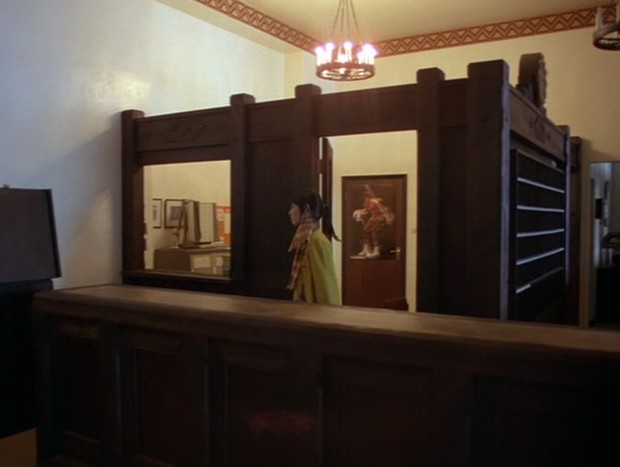
Fig. 6 - Our only view of the poster on the door in the switchboard room.
We see a much discussed poster, the subject of which has people wondering, "What is this?" Different people have different ideas. To me, one of the more interesting aspects of the poster is its capacity for inspiring an optical illusion like the internet meme spinning woman illusion. An article on About.com says of the spinning woman,
In reality, the spinning dancer illusion is related to bistable perception in which an ambiguous 2-dimensional figure can be seen in from two different perspectives. Because there is no third dimension, our brains try to construct space around the figure. Similar illusions include the Necker Cube and the Reversible Face/Vase Illusion...In a New York Times column, Thomas C. Toppino, chair of the department of psychology at Villanova University suggested, "What's happening here to cause the flip is something happening entirely within the visual system. If we can understand why it is these figures reverse then we're in a position to understand something pretty fundamental to how the visual system contributes to the conscious experience."
We have the same happening with this poster figure which can be seen from two different perspectives.
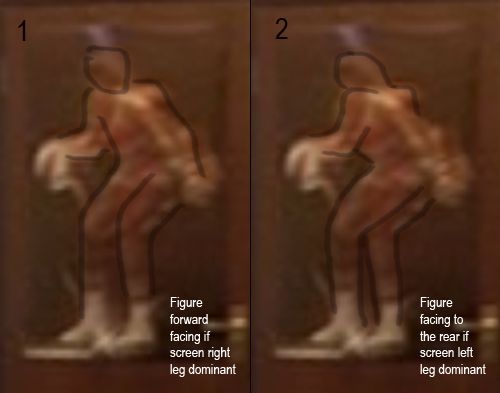
Fig. 7 - Bistable perception optical illusion
When, as in example 1, the screen right leg of the figure is viewed as dominant (forward of the other) by the observer, then the figure is seen as facing forward. In example 2, when the screen left leg of the figure is viewed as dominant (more toward the viewer than the right leg), then the figure is seen as viewed from the rear.
And that, to me, is what is most interesting about the figure. Never mind what the poster actually is. Viewed as staged in the film, we have this optical illusion.
We see down the hall beside the reception desk and that there are red doors that do not lead to elevators but to restrooms. To the left, we see the door to the service hall is shut.
For the first time, too, we get a clear picture of the phone booths in the lobby opposite the reception area.
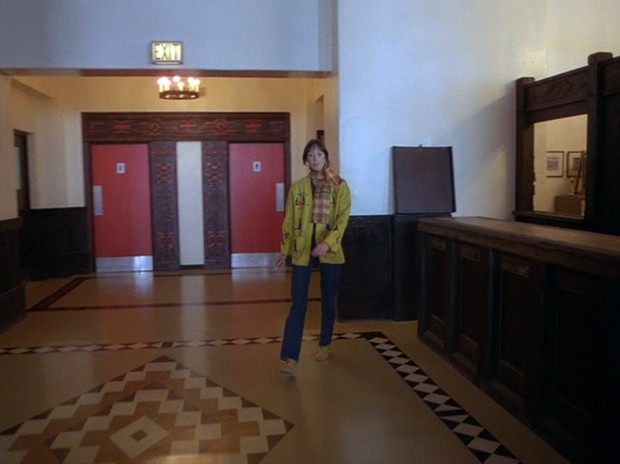
Fig. 8 - The first time we are able to see and tell the doors opposite the main entrance lead to bathrooms
As Wendy continues through the lobby, we see the television is on but not what is playing.
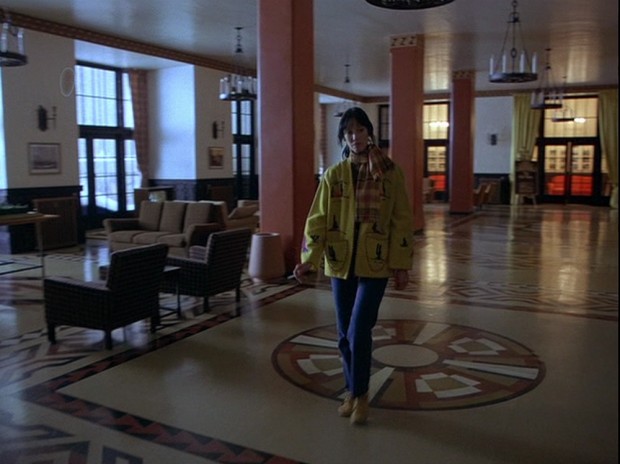
Fig. 9 - The television is on. The lobby's lights are off, as they always are when Wendy is in the lobby.
Coincidentally, as Wendy crosses over the circle where Dick is to die, an oval flaw appears in the film stock on the wall to the left, white enclosing a tan field. I saw this because I paused the film to get a shot that showed the television was on but we're unable to see what is playing, and for the brief period of time it is shown whatever is on the screen appears static and isn't moving. As usual, the lobby's chandeliers are dark.
She comes around and into the General Manager's office in order to use its two-way radio, and as she passes, just outside the door, the photos of the mountain, we begin to hear the howling wind. As she moves into the office proper, we see through the impossible office window the blizzard.
She calls out on the two-way radio.
WENDY: This is KDK12 calling KDK1.
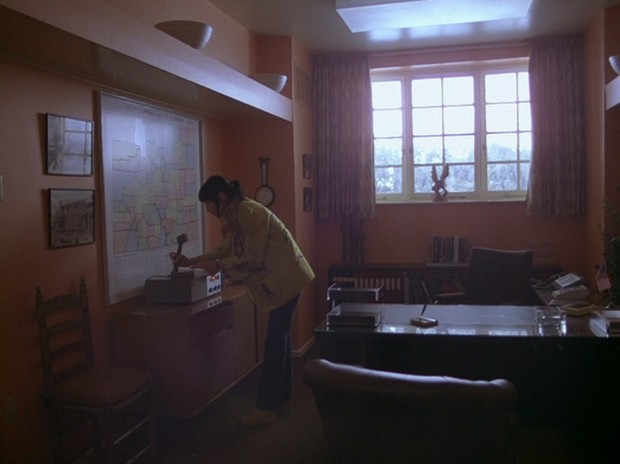
Fig. 10 - Wendy's only time in the office
217 MS forestry service office. (48:06)
There are three individuals in the forestry service office, a woman, an older man, and a younger man.
The time appears to be 11:40.
WENDY (off-screen): KDK12 to KDK1.
YOUNG FOREST RANGER: This is KDK1, we're receiving you, over.
218 MS Wendy. (48:14)
WENDY: Hi, this is Wendy Torrance at the Overlook Hotel.
 217 |
 218 |
219 MS Ranger. (48:18)
YOUNG FOREST RANGER: Hi, how you folks getting on up there? Over.
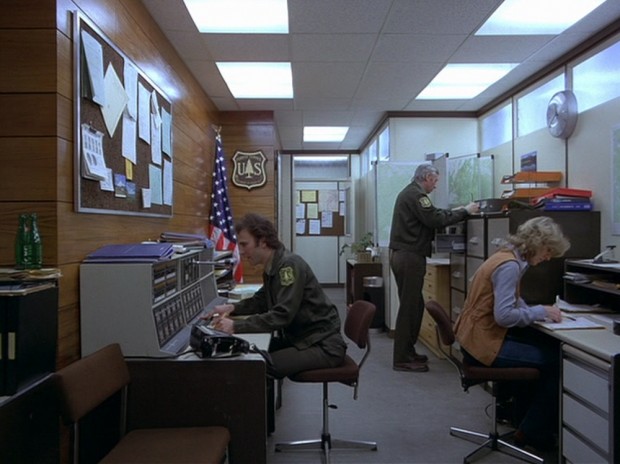
Fig. 11 - The forest ranger's office.
220 MS Wendy. (48:22)
WENDY: Oh, we're just fine but our telephones don't seem to be doing too well. Are the lines down by any chance? Over.
221 MS Ranger. (48:28)
Cutting back to the forest ranger, there are a couple small changes in his room. A white sheet on the cork board above is now pink and there is now a blue notebook sitting next to him.
RANGER: Yes, quite a few of them are down due to the storm. Over.
The transition in color from the white page to the pink reminds of an exchange between Kubrick's mother, Kubrick and Nicholson in Vivian's documentary on The Shining. Gert, Kubrick's mother, sitting at a table in the Gold Room, has asked what is the meaning of the different colors used for the scripts and Kubrick replies it has to do with the newer versions but that after a while you're lucky if people get the new copies. Nicholson clarifies you start with white, then blue, then pink, then green, then yellow. "So blue or yellow isn't significant, just colors," Gert says.

Fig. 12 - The forest ranger's office. There have been a few subtle alterations with the props.
WENDY (off-screen): Any chance of them being repaired soon? Over.
(48:36)) We hear a loud "sha", this time not concealed as ambient background noise.
YOUNG FOREST RANGER: Well, I wouldn't like to say. Most winters they stay like that until spring. Over.
222 MS Wendy. (48:41)
WENDY: Boy, this storm is really something, isn't it? Over.
223 MS Ranger. (48:45)
He confirms for her it's one of the worst they've had for years, then cuts short the chit-chat. Aware she is eager to talk, the ranger gently but pointedly ends the conversation, asking if there is anything else they can do for her.
YOUNG FOREST RANGER: Oh, yes, it's one of the worst we've had for years. Is there anything else we can do for you, Mrs. Torrance? Over.
224 MS Wendy. (48:52)
WENDY: I suppose not. Over.
225 MS Ranger. (48:54)
YOUNG FOREST RANGER: Well, if you folks have any problems up there, just give us a call. And Mrs. Torrance...
226 MS Wendy. (49:00)
YOUNG FOREST RANGER (off-screen): I think it might be a good idea if you leave your radio on all the time now. Over.
WENDY: Okay, we'll do that. It was real nice talking to you. Bye. Over and out.
Wendy's loneliness and pleasure with even having briefly spoken with another person evident.
 220 |
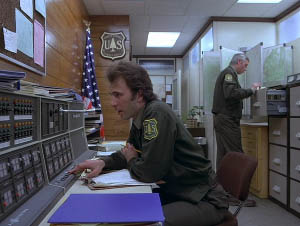 221 |
 222 |
 223 |
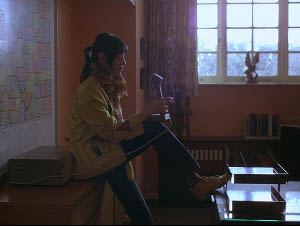 224 |
 225 |
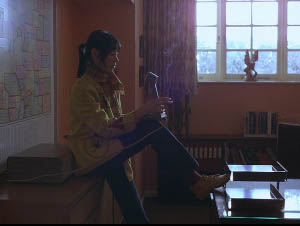 226 |
|
In the ranger's office, to the left we'd seen a US flag, its white stars reflected in the sheen of the wood paneling, and on the right there had been a stand of maps. In the Overlook office, the little U.S. flag is on the desk and there is no Colorado flag. Instead, above the nearby two-way radio is a Colorado map. Whenever the US flag appears, if there isn't the Colorado flag on the other side, there are instead maps of Colorado. In the Game Room and Colorado Lounge there are the U.S. and Colorado state flags.
I've always loved this scene because of its picturing Wendy's loneliness, her pleasure derived from this brief conversation, and the subtle eagerness of the ranger to disengage.
DANNY'S FINAL VISION OF THE "TWINS"
THE MIRROR FLIP OF THE TIME FROM 11:40 to 6:10 - THE OPEN CABINET OPPOSITE THE TIME CARDS FORESHADOWS THE CABINET IN WHICH DANNY WILL LATER HIDE - DANNY CONFRONTED BY THE SHINING OF THE MURDER OF THE GIRLS - THE CEILING LAMPS OF THE STAFF AREA - THE PECULIAR DOUBLE KNOB SUSPENDED IN SPACE
Because of the shoe heel beside the vision of the dead girls in this scene, and its resemblance to the horse shoe in the switchboard room, one may want to read the post Stanley Kubrick, Anamnesis, and His Use of Railroad Imagery.
227 LS service hall. (49:16)
The camera now tracks Danny riding his Big Wheel through the green service hall behind the lobby, in the direction of the phones and an area supposedly behind a Gold Room hall.
The clock reads 6:10. At the rangers office we had seen the time was 11:40 and this is that flipped upside down.
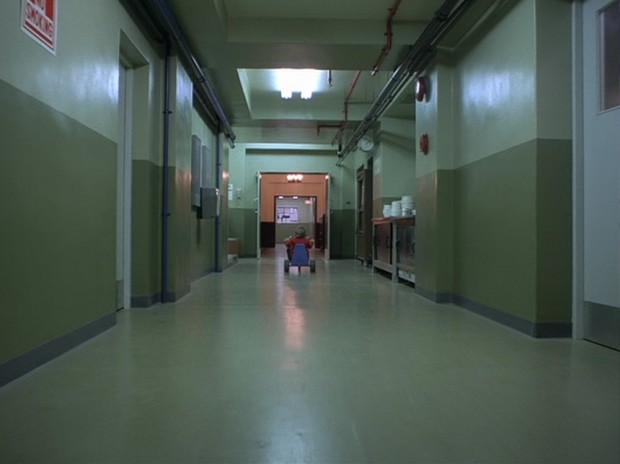
Fig. 13 - Danny in the service hall. A no smoking sign is seen. The clock reads 6:10, whereas it had been 11:40 when Wendy spoke with the ranger.
He passes a pair of cabinets on the right, opposite employee time cards, and we see one of the cabinet's doors appears to be open the same amount of space as also will be the cabinet Danny later hides in that is further down the hall. When he later hides in that cabinet, we will get a glimpse of this one and it will then appear to be closed.

Fig. 14 - The cabinet with the open door, opposite the employee time cards.
If we examine that first cabinet on Closing Day, we'll see that it is also open there. The area is brought to our attention by a man in green coveralls stacking dishes on the cabinet. After Ullman, the Torrances, and Bill Watson pass by, this individual rather conspicuously crosses from that cabinet to enter the the door that leads into Ullman's office, Ullman glancing back at him as he does so.
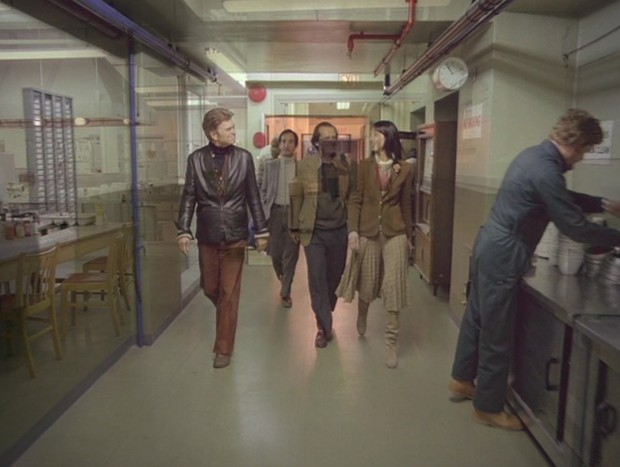
Fig. 15 - The cabinet with the open door on Closing Day.
Note the difference in color temperature in the hall and that the green is more florescent, more like that green we see in connection with eerie scenes, such as the green in the stairwell of Room 237's second floor, and the green in the bathroom of Room 237. The color temperature of this green is more olive.
Cycling on, Danny passes a coffee machine, cigarette machine. Above a water cooler on the left we see a sign that reads "Please put cups and other garbage in the bins provided." One may remember the admonition to keep America clean.
At the end of the hall, Danny turns right.
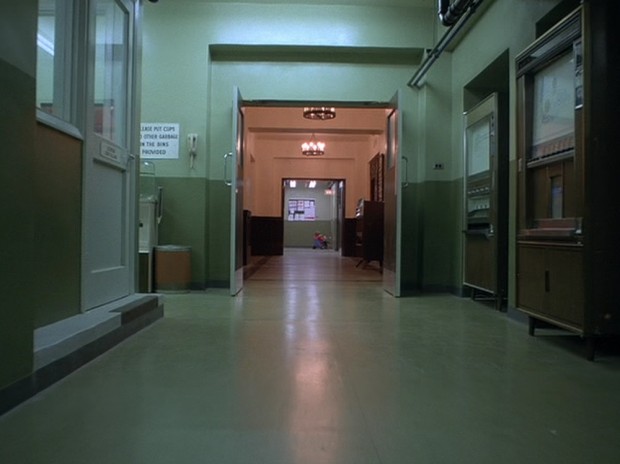
Fig. 16 - Danny cuts right into an area we will never view in the film.
What are those white dots behind which he appears to pass?
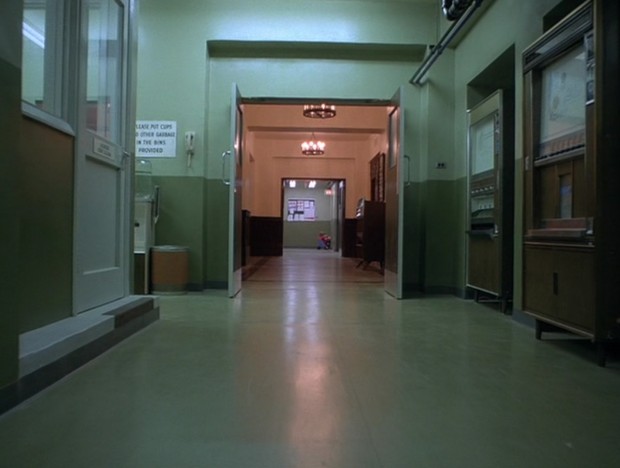
Fig. 17 - I'm unable to tell what the white dots are behind which Danny passes.
We are briefly able to see from this back service hall into the switchboard room in which Danny's mother had earlier failed at placing any calls out.
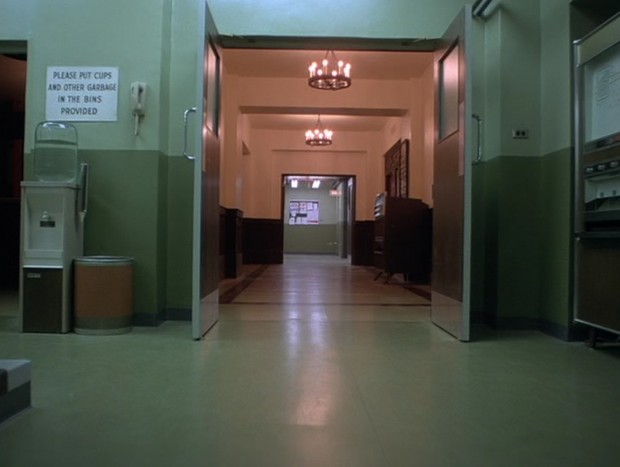
Fig. 18 - A brief view from the service hall into the now darkened switchboard room.
If we think back to Closing Day, it was toward this green service hall that Jack and Ullman went to collect Danny from the Games Room. So, he has turned in the direction of what Kubrick has shown us would possibly be the Games Room, where he saw the girls that day. The audience member who is seeing the film for the first time does not likely know yet where this hall is located. Though we have a glimpse here of wainscotting such as seen as in the lobby, this green service hall is still free-floating, its placement unsecured. We don't know we are seeing into the darkened switchboard room.
228 MS Staff hall. (49:32)
Next, Danny is in the staff area with the blue carpet and blue-flowered wallpaper, passing on his left a service cart with two coffee urns, the shelf underneath stacked with cups--and though they are ceramic rather than paper, that they appear immediately subsequent the sign's request to discard cups and other garbage, suggests a link. There is also a coffee vending machine on the top of which are two identical cardboard boxes perhaps holding refills. On the left, in an enclosed glass cabinet, is a fire extinguisher.
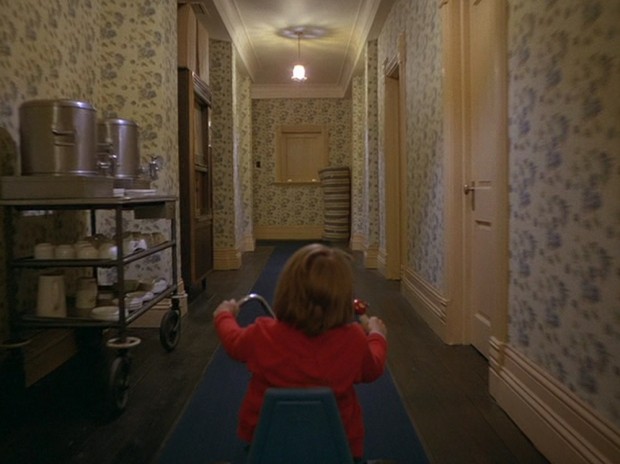
Fig. 19 - Danny cycles past coffee urns in the staff quarters area of the lodge.
At the end of this hall is a dumb waiter and a rolled, blue-striped mattress standing on end in the right corner. In the previous scene with Wendy, she'd been wearing the jacket on which was the napping individual. As I've discussed elsewhere, I see in "shining" also ShNH, meaning to double, fold, replication, also being cognate with to sleep. Here, we see a rolled up mattress and we are about to have a shining of the wo near identical girls. There are parts of my analysis that I think of as being significant and essential, and others that I think of as "hmmm, maybe, maybe not". ShNH is something I don't think is essential, is a "maybe, maybe not", but I enter it in, as with other things, with that caveat.
The dumbwaiter suggests this hall may have a relationship with the kitchen. As a dumbwaiter, it may also bring in the idea of "dumb" as in muteness, because a dumbwaiter's very name refers to it being a silent waiter. Have we seen other waiters in the film? Yes. On the day of the interviews, when Jack was arriving, a waiter had carried a tray over to a group of people seated where Jack would eat his lunch on Closing Day. The waiter had then effectively disappeared with the tray. On Closing Day, When Ullman and Bill approached Jack in that area he was reading Playgirl and finishing lunch, a similar tray beside him. Jack and Ullman then went to collect Danny from the Games Room. This seemingly didn't happen as we were next shown Ullman, Jack, Wendy and Bill walking through the Colorado Lounge, after which we had the scene of Danny in the Games Room seeing the girls.
We are about to see the girls and they are about to ask Danny to come play forever and ever.
Reaching this curled mattress, Danny takes a left, we to then see a rolled up rug leaning against the right wall.
He is in the flowered hall of the vision of the two girls. And they are there. He stops abruptly.

Fig. 20 - The two girls await Danny. As Danny clears the corner and sees them the first light is prominent in the window.
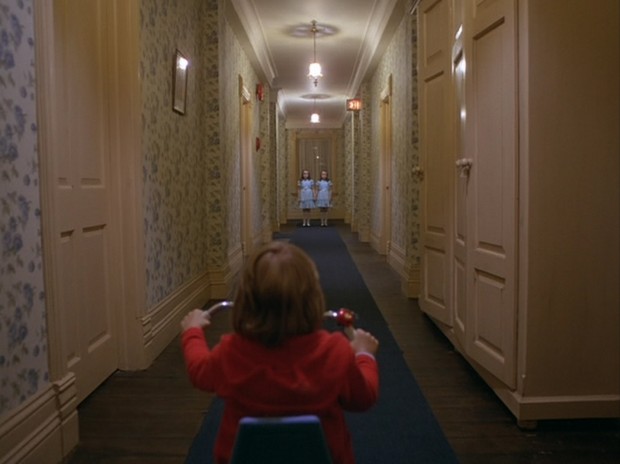
Fig. 21 - The two girls await Danny. As Danny comes to a stop, the second light is prominent in the window.
Above the girls are two lamps suspended from the ceiling. Fluted globes, they cast shadows on the ceiling in the shape of spoked wheels.
The chandelier ceiling lamps throughout the lodge quite often cast stark shadows of their spokes on the ceiling, the only sure time this not happening, of course, being when the lamps are off, such as every time Wendy is in the lobby. In this staff wing we have no chandelier lamps with obvious wheel spokes, but spokes we shall have. The gently fluted globes of the ceiling lamps cast a stark wheel, their inner spokes being five, reminiscent of the pentagram, from which radiates a kind of static whirl of illumination.
In Killer's Kiss the decor of Gloria's and Davey's "mirroring" rooms included wheel wagon lamps popular for the time. In The Killing there was also a wheel wagon lamp in Marvin's apartment. In a way, the lamps with their wheel shadows return us to those.
There is an EXIT sign on the right and on the left a fire alarm bell.
When Danny cleared the corner, as we first saw the girls, the top light was most prominent in the window, its reflection burning brightly, which would be the lamp closest the girls. When Danny comes to a stop, a split second later, then the lower light is the one that is burning brightly in the window, the one above barely seen. In shot 233 both lights will be about the same. I think it's another expression of dominance, ascendancy, which aspect of the doubled thing, the thing which can be seen in different perspectives, is the one foremost, just as has been just illustrated with the poster.
229 CU Danny. (49:42) We cut to a reaction shot of Danny.
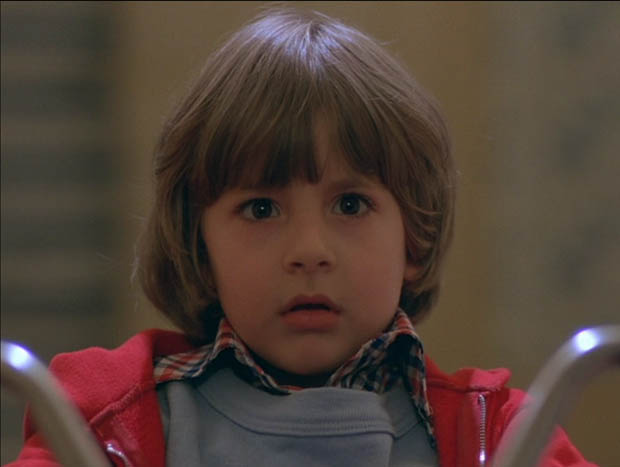
230 LS girls. (49:45) Then back to the girls.
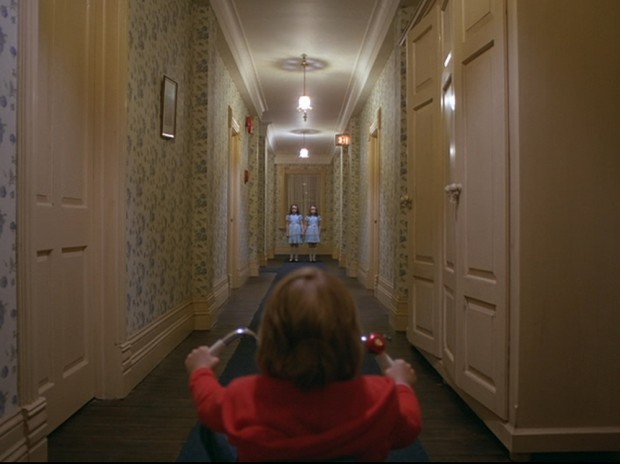
Fig. 22 - The two girls and Danny.
THE TWO GIRLS IN UNISON: Hello, Danny.
231 CU Danny. (49:50) Danny stares.
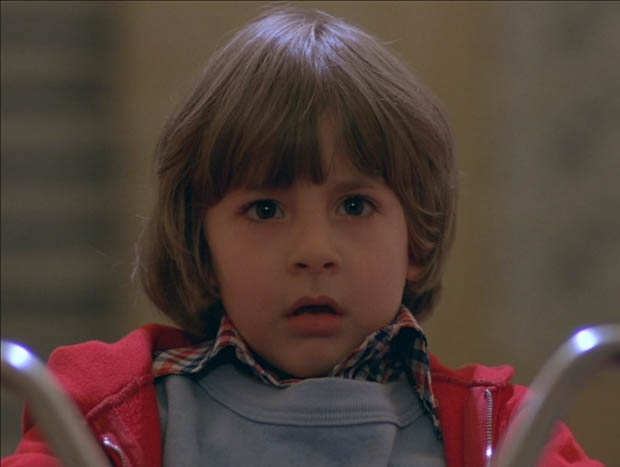
TWO GIRLS IN UNISON (off-screen): Come and play with us.
232 LS Girls from behind Danny. (49:59)
TWO GIRLS IN UNISON: Come and play with us, Danny.
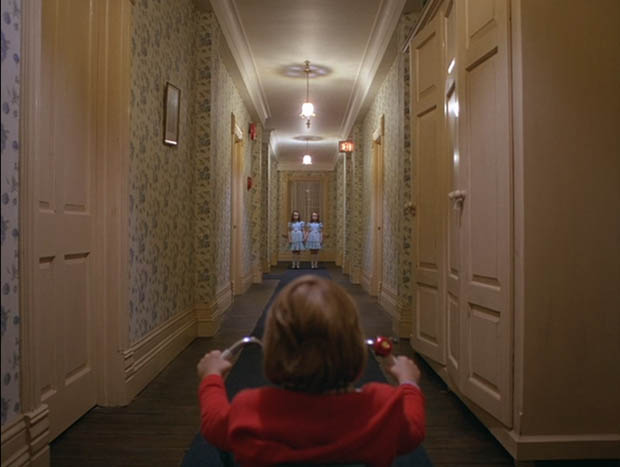
233 MS. (50:06) An image of their bodies hacked and bloodied in the hallway.
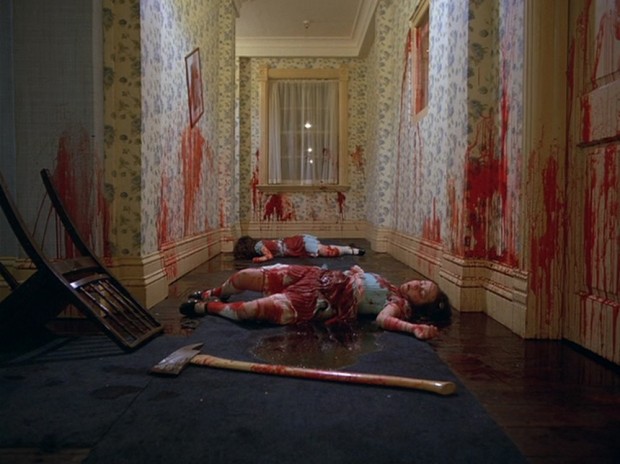
Fig. 23 - Danny's horrifying vision of the two dead girls.
234 MS. (50:06) Cut to the girls unbloodied.
TWO GIRLS IN UNISON: Forever...
The eye is drawn to an object on the ceiling between the two lamps. One might assume it is a knob, a spigot for spraying water in case of fire, but we see such a spigot, I think, in the images of the bloodied girls, in the ceiling before the window, and it is unlike this. Whatever this knob is in the ceiling, it is mirrored/doubled, perfectly presenting the idea of "as above, so below", and is suspended in and highlighted by a white light that stands out from the more yellow illumination given off by the lamps. This white light surrounding the double knob seems to me to be highly artificial, a special effect, I see no light source for it. And the knob, as well, its shadow is also decidedly artificial as it is a mirroring rather than a shadow. That this peculiar knob and its mirror image now appears seems to complement the girls.
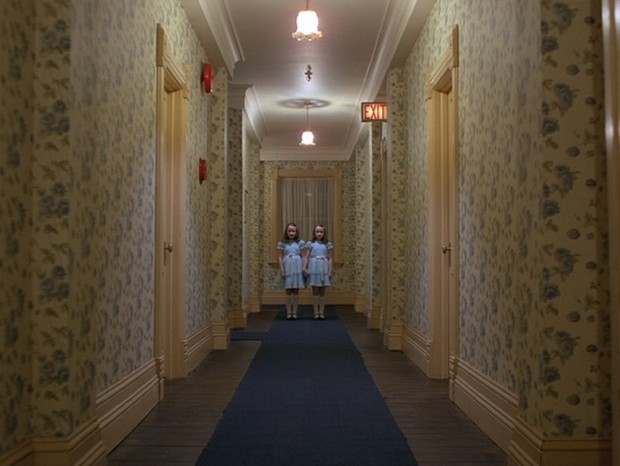
Fig. 24 - The double knob in the ceiling observed as the girls invite Danny to play forever.
There is now only one dim light in the window, the one closest to the girls.
235 MS. (50:08) Another shot of the axing.

Fig. 23 Danny's horrifying vision of the two dead girls.
There are now three lights blazing in the windows. This seems to be in accordance with Kubrick sometimes giving us three perspectives. We have seen one of two lights in ascendance, then the second of the two lights as the dominant one, and now we see three blazing lights.
Kubrick's not done with the lights yet.
236 CU Danny. (50:09) A shot of Danny starting back in horror.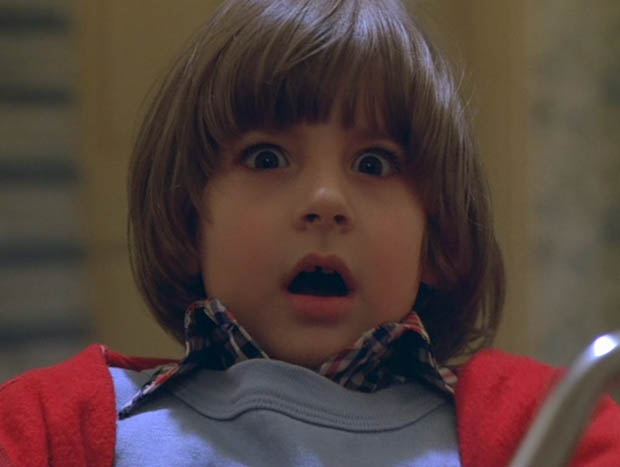
237 MS. (50:10) Then back to the girls unbloodied.
TWO GIRLS IN UNISON: And ever...
Note that here we don't see one light above another shining in the window, that instead we see two lights side by side, or one light appearing to be split.
238 MS. (50:12) Followed by another shot of the bloodied hallway.

Fig. 23 Danny's horrifying vision of the two dead girls.
These shots of the bloodied girls in the hallway don't change.
239 MCU. (50:13) Then back to the girls speaking.
TWO GIRLS IN UNISON: And ever.
Their eyes appear hollowed and absent, their faces as masks.
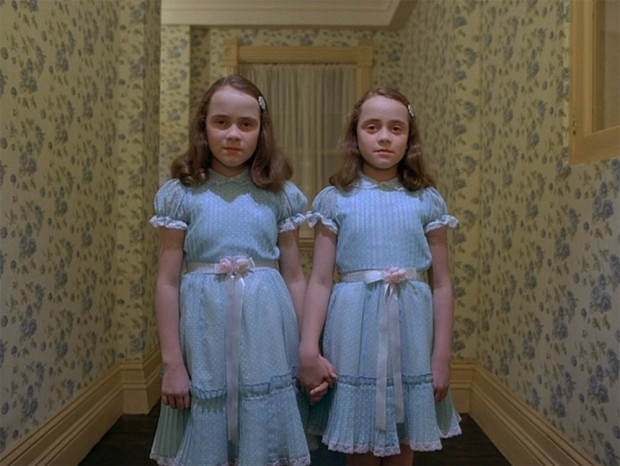
Fig. 26 - A closer shot of the two girls.
The reflections of the two lights are low in the window now and barely discernible through the drapes.
240 MS (50:15) And return to the bloodied girls with the crescendo.
One girl lies on her back and behind is the other girl on her stomach, as if they are flip images of each other--just as the clock was flipped earlier, 11:40 becoming 6:10. Before them lies an axe. To the side is a toppled chair. A little of the blood has splattered onto the blue paper in the connecting hall in which the chair lies. Reflected in the window behind the girls are three lamp lights.
Because the girls lie "mirroring" each other, I consider if we had a mirroring of the axe it would be as a labrys, a double axe that is associated with the maze.
Earlier, above the cork board in the switchboard room, we'd observed a horseshoe. Lying before the black patent leather shod foot of the first girl is the heel of a shoe.
The heel would appear to have belonged to the shoe of the murderer.
As Kubrick has chosen to use music concerning the biblical figure of Jacob, do we have hear another reference to Jacob, the name meaning heel catcher, the idea being that when his twin Esau was born, Jacob was grasping his heel?

Fig. 23 - Danny's horrifying vision of the two dead girls.
Observe the white dots littered about the carpet. I'll address these in a later section.
I mentioned earlier that we see perhaps the spigot of a sprinkler system in the ceiling above the murdered girls, and that it clarifies for us the other strange knob is not such. Below is a blow-up of the spigot.
Kubrick deals with deja vu and repetition. The pattern of the wallpaper is such that the cloned, repeating pattern is undisguised.
241 CU Danny. (50:16)
Danny covers his eyes with a screeching crescendo of horns. In a close-up of him we see in the distance the blurred mattress, the horizontal blue and white stripe of which is now prominent and recalls the horizontal stripe of the pocket on the blue and white vertical stripe apron Wendy was wearing in the Tuesday scene when she was operating the can opener, which preceded his vision of the girls at Room 237.
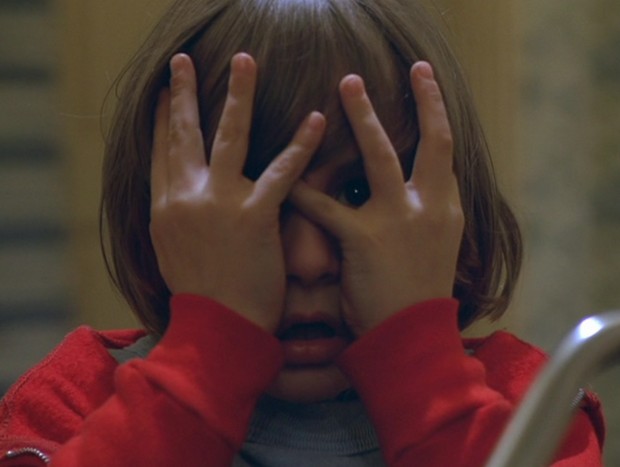
Fig. 28 - Danny peeks through his fingers.
242 MS Staff hall. (50:29)
When Danny opens his eyes again the girls have disappeared.
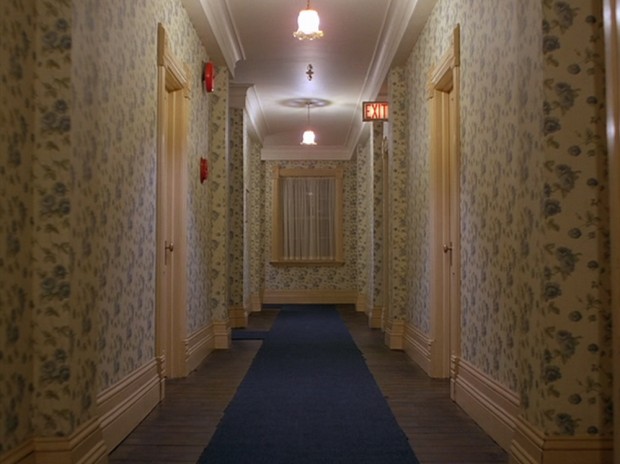
Fig. 29 - The now empty hall with its peculiar double knob in the ceiling.
The floating metallic thingamabob between the two lights is an odd occurrence, and I would think that the "ghost" doorknob observed in the wall beside Room 237 in the "Tuesday" section is associated with this, for there is a distinct similarity between the doorknob and this dual knob suspended between the two lamps, floating there, absolutely surreptitious and inconspicuous with the focus of the viewer being riveted on the girls, just as in the "Tuesday" section the viewer notices neither the ghost doorknob or the open door of room 236 as focus is entirely on Danny and the the double doors of Room 237.
The double knob stands to be compared with the island in the opening shot of the film.
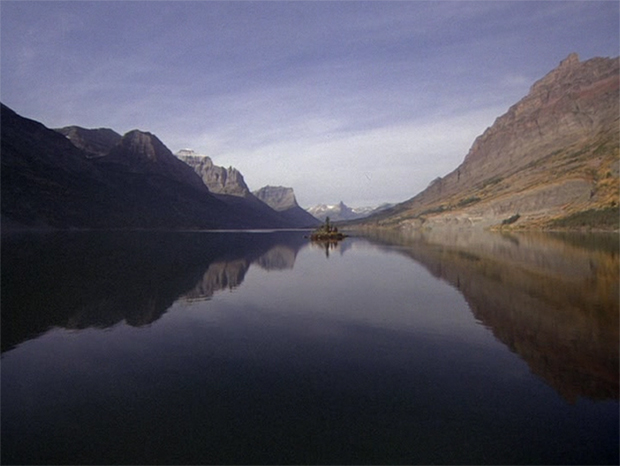
Fig. 30 - The island and its reflection in the opening shot
We may also see in this the design with the two arrows before the main door of the lodge.

Fig. 31 - The design before the lodge's main door.
Also, Room 237's door knob and its reflection, seen during Danny's prior shining of the girls.
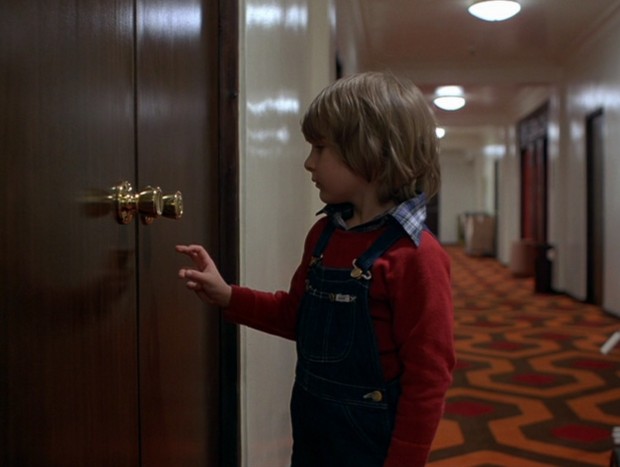
Fig. 32 - The reflection of the doorknob in Room 237.
We also have another anomaly with the first lamp in the hallway where Danny sees the girls. It casts also an unusual shadow on the ceiling and seems as though it shouldn't be there if we look at how the bases of the other lamps are constructed and the manner in which they shine and cast their shadow on the ceiling. Consider the upward pointing dart-shaped shadow in the central image below, not observed with the other lamps in the halls.
The shadow dart or arrow shape, which shouldn't be there, is much like the mirrored knob between the two lamps, and these two anomalies complementing each other function a good deal like the ghost doorknob in the scene where Danny tried the door to Room 237 and it was locked. The ghost doorknob only appeared when the door opposite was open but hidden, the viewer led to believe a door was there and closed due the latch plate reflecting light in a way that the viewer assumed it was a door knob. The ghost doorknob on the wall opposite was rather a commentary on the mirage of a doorknob that was instead the latch plate, which was a kind of trick and misdirection. We have the same thing here. One anomaly indicates and comments on another which is much like it and both are mirages.
The purpose of the anomalies is something else.
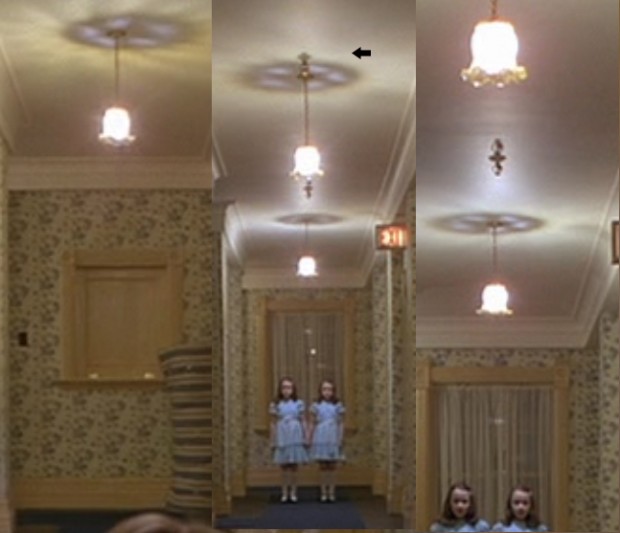
Fig. 33 - The anomalous dart shadow above the lamp between Danny and the girls.
243 CU Danny. (50:32) A close up of Danny recovering.
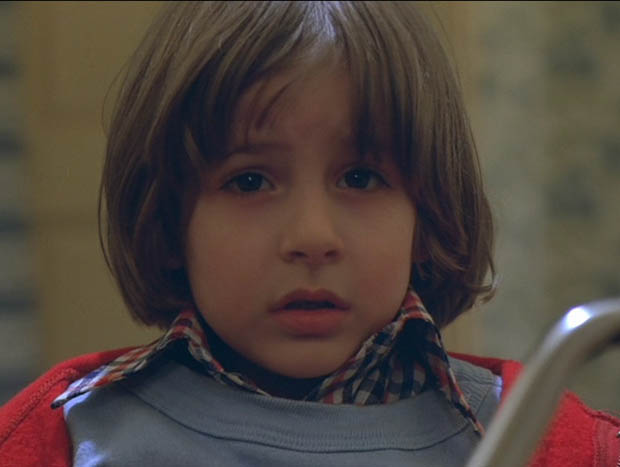
244 MS of hall from behind Danny. (50:41) Returning to from behind Danny's perspective.
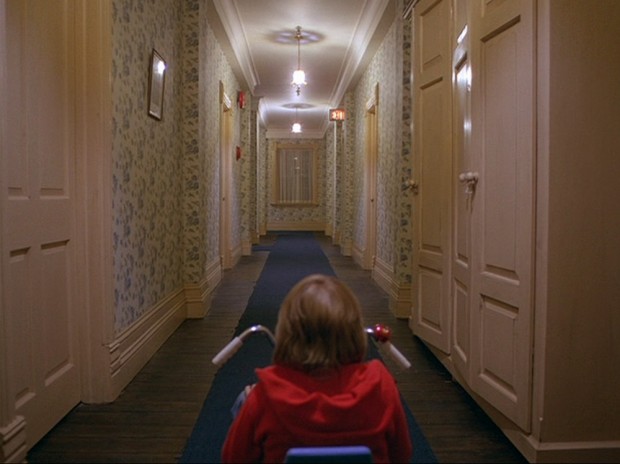
Fig. 34 - The camera returns to behind Danny, including him again in the shot of the hall.
245 CU Danny. (50:44)
DANNY: Tony, I'm scared.
TONY: Remember what Mr. Hallorann said, "It's just like pictures in a book, Danny, it isn't real."
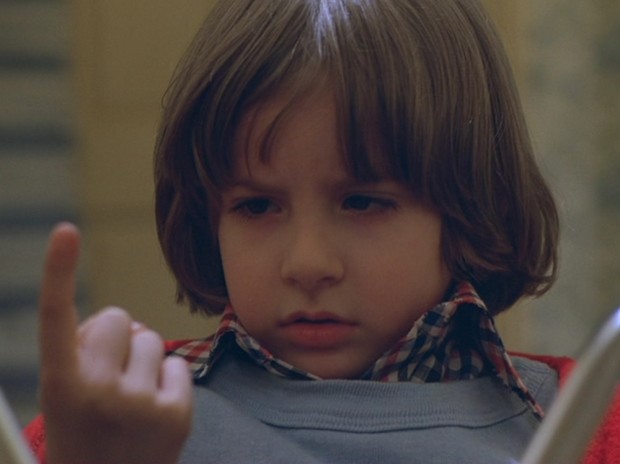
Fig. 35 - "It's just like pictures in a book."
Now, take a look at the above pictures of the girls compared to their previous appearances. As shown below on the day of the interview, in all former shinings of them the girl on the left is the dominant one standing with her arm over that of the girl on the right.
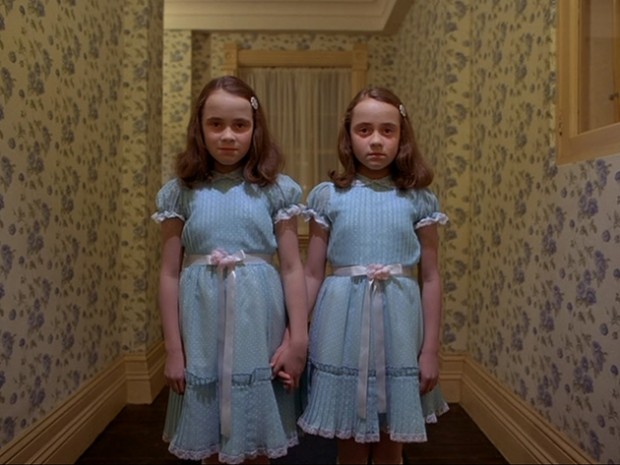
Fig. 36 - The two girls as viewed in the mirror in the Boulder apartment bathroom.
In the images below, when the girls are briefly viewed as Danny looks at the number of Room 237, it is barely perceptible, as the glimpse of them is so brief, but Kubrick chose a clip in which the girl on screen right moves, the first finger of the screen right hand coming slightly forward. However, overlaying the two images, it seems that the girl's heads are slightly shifted ever so slightly forward in the second view as well, so in that brief glimpse of them their heads tilt a little toward the camera.
Again, the girl on screen left is the dominant one, her arm crossed over the other's.
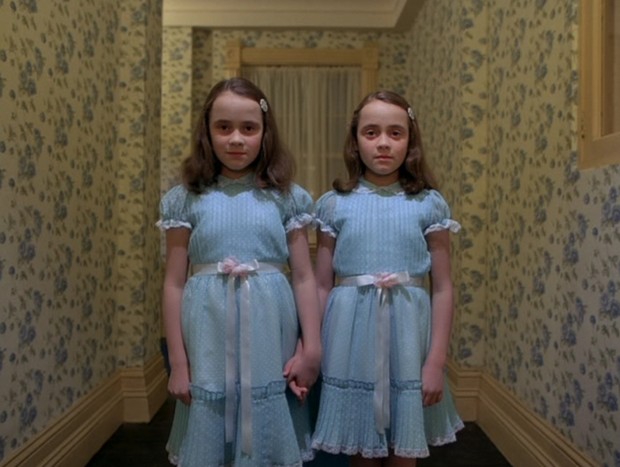
Fig. 37 - The two girls as viewed in the left door of Room 237.
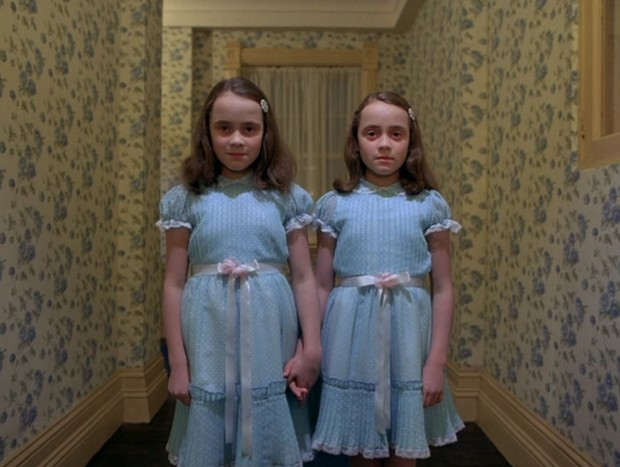
Fig. 38 - The two girls as viewed in the left door of Room 237. Their heads tilt slightly forward toward Danny.
Or, in a gif...
I think it's important that these aren't identical clips.
The dominant girl has been reversed in the vision Danny has when he is himself in the flowered hall. When he is in the flowered hall, the girl on the right consistently has her arm over that of the the girl on the left.
These shots have been staged so that they are, otherwise, almost exactly the same. Almost. Look at the folds of the dresses and how the ribbons drape, they are the same. The placement of the girls in the hall is the same, and even their skirts measure about the same distance from the walls. Their unlinked arms are almost but not quite exactly the same, positioned ever so slightly different, but the print of the wallpaper behind their figures and how it relates to their outlines is an exact match. Their hair, when Danny is in the flowered hall, is different. The girl on the left, previously, has hair that is slightly frizzy at the ends, while the other girl's hair is perfectly curled. The situation is now reversed, the girl on the left has the hair that is perfectly curled at the ends, and the other girl's hair is not.

Fig. 39 - The two girls as they are in Danny's fourth vision, in the hall. The girl on the right now has the dominant arm.
As we'd observed with Jack in the Colorado Lounge, when he is speaking with Wendy and the table and chair sometimes disappear behind him, we have continuity staged here so that it is both precisely the same while also ever so slightly different, which leads one to believe the differences are purposeful. Things are just off enough that they perhaps have a grating, subconscious, psychological impact on the viewer, or they are different for another reason.
The wallpaper currently in the hall, which is the same as in the vision, we are at least led to believe is quite old, and I have difficulty believing that an exact replacement would have been found for the old bloodied wallpaper if the murders of the girls had happened recently--or if it was the murder of a single girl who becomes doubled in Danny's visions. Kubrick has sketched things so we certainly assume these are the two Grady girls, eight and ten years of age, who were killed by their father with an axe, and they likely are. But I still wonder at the bloodied hallway having been restored with the same wallpaper, even the bloodied picture on the wall above them salvaged rather than thrown out. Just as the office window was impossible, and so many rooms are impossible rooms, the restoration of this hall after the murder of the girls is fairly outrageous. And why, after all, does the staff wing have the blue wallpaper and this flowered wallpaper as well? Why don't we see this blue flowered wallpaper any place else in the staff wing? Is it because the blue flowered wallpaper isn't there any longer at all? Where we see the blue flowered wallpaper is it actually now instead papered in the same blue as the rest of the staff area? I don't think this question can be answered, but I do believe presentation promotes the inquiry, and we do well to remember it when Jack has his confrontations in the Gold Room. It may be that we, the audience, observing the blue flowered wallpaper consistently in views of this area of the staff wing, are seeing something that is no longer.
COMPARISON WITH 2001
Let's first start with Danny viewed from behind his Hot Wheels.

This may be compared with the pod as it turns then makes it's move to kill Frank. Bear with me here...
Next, in 2001, we have 5 rapid shots zooming in on HAL's eye in the pod (shots 371-375). The 4th shot, before the extreme close-up of the eye, is the one below.
In HAL's eye, we see three white lights, the upper one decidedly separate from the other two. Kubrick repeats these 3 lights in Danny's vision of the murder scene of the two girls, when he's in the hall, in shots 233, 235, 238 and 240. Each shot between is of the girls instead standing, each shot zooming in closer to them, just as we have in 2001 several shots dramatically zooming in on HAL's eye.
These 3 brilliant lights in the window only occur during the shots of the murder scene. In a sense, the red of HAL's eye, beneath those three bright white lights, becomes the red of the blood that covers the girls.
The camera returns to Danny with his hands over his eyes. He separates his fingers so we see one blue eye peering upon the scene, the vision of the murder scene now absent.
Just as the girls are pseudo twins, if they are eight and ten years of age (though the actresses are twins), in 2001 there was the pseudo twinning of the astronauts, the one who duplicated the actions of the other being the one who was murdered.
If we look back to the Tuesday section, through Danny's encounter with Room 237, during which he sees the girls, we have also three lights, which may hook into the theme above.
I remark a little more on this in the 4th section of my analysis of 2001.
THE POSTER AND THE GIRLS
Now, let's go back to that figure on the poster on the door down in the switchboard room.

Fig. 40 - The two perspectives had in the poster through the optical illusion.
Right leg forward we have one perspective of the figure. Left leg seen as dominant and forward and we have another perspective of the figure, a reversed one.
Up until this scene Danny had seen the girls with the screen left girl dominant. Now, it is instead the screen right girl. And it has everything to do with, I believe, why this particular poster is found on the door, because of the optical illusion and something which can be seen from two different perspectives.

Fig. 41 - A switch in dominance of the girls, with most everything else in the shots painstakingly duplicated, with the exception of which girl's hair is not as curled.
We can certainly compare this with the two girls lying in such a way that one is a flipped version of the other.
CALL US
The forest ranger had just told the lonely Wendy to keep the radio on and, cutting her off when she obviously desired to speak, said if she had any problems to call "us", that "us" echoing the letters U and S to either side of the tree in the forest ranger emblem. In the next scene, Danny, also lonely, cuts around the hotel's corner and sees the Grady girls who invite him to come and "play with us" for ever and ever and ever--and what is a child's version of heaven but to play for ever and ever?
Danny's seeing the girls is a re-expression of Wendy's speaking with the forest ranger on the two-way radio, her loneliness and her desire for community.
AS ABOVE, SO BELOW, JACOB'S LADDER AND THE SABBATH - ON CYCLES REPRESENTED IN ShV AND KDK
The following notes on the web from a class of Rav Soloveichik addresses "as above, so below" in relationship to Jacob's Ladder and the Sabbath:
We consider Jacob's dream and the ladder which he saw rising to the heavens. The angels looked at the image of Jacob as from above and some as from below. All men have two images. One is man below--as he is--and the second is the heavenly image as engraved in the celestial throne. On one hand, he is a reality (below). The above image represents the non-concrete man. Below tells what he actually is; above tells what he could be. This double image theory therefore makes t'shuvah (repentance) possible. The image above is not involved in sin and pulls him up. This can occur in a single second, one thought. When a man realizes he has failed in his sin (his lower image), this is his first step to repentance. Chatatati (I have sinned) means "I have failed." For example, we think of the Beit Hamikdash (Temple as below and above. Below, it was concrete--reality, built in a geographic spot, existed and was destroyed. Moses said in his song, "You bring them in and plant them." That is the image of below. The Beit Hamikdash as a vision is never destroyed.
Another example is the double image of Shabbat. What is it? Food, rest, relaxation? Yes! But the image of Shabbat above is metaphysical--a world without death--a world of purity and beauty. "Shabtotei tishmoru" (My Sabbaths you shall observe) is written in the plural because of the double image.
I go to the idea of the Sabbath (from Sheva, seven) because it is Saturday and Jack is seen working in the Colorado Lounge. He will later be revealed as obsessed with his work (the defining phrase concerning him, eventually revealed, is "all work and no play makes Jack a dull boy") while Danny is invited by the girls to play forever and ever, and this is the first and only time he hears them speak so they would seem to be most fully realized for Danny in this scene. Kubrick brings in also the idea of rest (and perhaps, too, the sleep of ShNH) with, in this section, one of the images on the back of Wendy's jacket being a person resting against a cactus during a siesta, corresponding with the Sabbath being a day of rest.
What is play if not resting from work? It is appropriate the girls should beckon Danny to play with them forever, then, on this day, on the Sabbath. Danny is being given the opportunity to never work again, to always be in a state of Sabbath.
Seven is also expressed in this section with the return of the 7 Up bottles. We see 3 of them, I believe, in the forest ranger office. The last time we saw 7 Up was Closing Day when the Torrances were on their way down to the boiler room with Ullman and Watson. We had a crossfade from that scene to Danny in the kitchen with Dick, eating his ice cream, and Dick had told him what was shined in the hotel was like toast.
The ShV of seven is perhaps present in the U▲S forest rangers insignia. The flag beside the plaque reflected on the wall, if we were able to pursue that reflection further we would see, instead of U▲S, a S▲U.
How so? Where do I come up with that whacked out idea?
ShuV, a word for "to turn" or "to repent", is connected also with seven. As with the word teshuva, it connotes completeness. Concerning the opening sequence of the film in particular, with its use of "Dies Irae" for the music, I've commented on this bringing to the movie ideas of judgment to be found in Rosh Hashanah, upon which "Dies Irae" is partly based.
Leonard Bosman's Meaning and Philosophy of Numbers relates:
The root of the word (meaning seven), ShuV or ShV, expresses, according to the best authorities, the idea of return...the completion of a cycle, a consummation..."a return to the place from which one set out". This root is joined to the root OU meaning a cycle, or "to turn upside down", hence a revolution. Thus the word "seven" means not only one thing repeated seven times, but refers also to a cycle of days, weeks or ages, during which a certain work--human, terrestrial, or cosmic--is consummated and returns on a higher spiral, with the additional characteristics moulded into it during the "sevening" period, to the status quo ante. After these period of "sevening", whether weeks, ages or periods of evolution, man and the Universe return to rest to prepare for a new revolution or "sevening".
The primary idea I'm looking at here is that of a return to a previous state, in which we can see a kind of reparation. As noted earlier, it is in this section, when Wendy is speaking with the U▲S forest ranger, that we hear the loud and distinct "sha" after she asks when the lines will be repaired. And if we turn U▲S around, as in completing a cycle, a reversal, a return, we have S▲U.
Another expression of this cycle, this reversal and return, is seen in the call signs for the Overlook and the forestry service. The Overlook's call sign is KDK12 and the forestry service's is KDK1. KDK was a kind of amateur two-way radio popular back in the 80s, so I imagine that is where Kubrick got the idea for the KDK. The forestry service isn't using a KDK, however, they're using a General Electric, and the radio at the Overlook is a General Electric Executive II.
These girls, who we could even call the Playgirls (referring back to the Playgirl magazine that Jack was reading in the Closing Day section, seated in the lobby), who want Danny to play forever and ever and ever, are the burned toast remnant that still lingered, which had not been yet put to rest. Danny, however, seems to silence this particular apparition, at least for himself, as this is the last appearance of the girls to him. Whereas Jack will be seen to conjure, to invite and not put to rest, Danny puts his hands to his eyes and casts at least this particular vision off, reminding himself that these are only pictures, not real.
Except, well, what happens next but things get physical in Room 237.
There are ideas to which I'm pretty well attached. The above idea of ShuV or ShV I'm still kind of sorting out. I may one day decide it doesn't really work out.
Due the ideas of doubling and the twinship of above/below aspects, I'm not confident we're seeing two distinct girls here, as in Grady's two daughters, but one who stands alongside her double. Is that why Kubrick changes it here so that the screen right girl is the dominant one? Why has one or the other for some reason entered a position of dominance?
SHA AND SHOAH
Other perspectives, I think, are present in the film concerning the "sha" sound, such as, I believe, the sha that means sheep, such as the sheep that Abraham told Isaac would be provided. The word for sheep comes from sha'ah, desolation, destruction the concept of rushing as in a whirling to giddiness (we have the turning too with ShuV), which is the word used for the holocaust, I believe. That, I think, is also here in the film, Shoah, the holocaust, and fits with our first hearing the sound when Jack crosses where he will later kill Dick.
RETIRING THE BIG WHEEL
Perhaps it is notable, concerning cycles, that after this section we will no longer see Danny's Big Wheel. Kubrick now retires it completely. Danny ceases his cycling revolutions about the lodge.
In review, what has Kubrick given us in this section?
Scary girls speak!! The hearts of half the audience hit pause!!
What's the teaser candy bait?
Who's going to notice teaser candy bait with those scary girls and that blood all over the carpet and the walls??!!!
What's the distraction?
First time you see it, even though you're kind of expecting them, the girls do scare the hell out of you, appearing like that right around the bend.
What's the Food for Thought?
The poster of the presumed basketball player and the doubled knob in the ceiling.
What's the deep infrastructure?
What the two girls represent in accordance with the poster. The double knob in the ceiling etc. These things also require reflection in relationship to the double doors for Room 237 and the room number being on the left door rather than the right (the few other double doors we see on that floor having the room number on the right door). I begin to look at the double-doors as being not so much a design detail suggestive of Room 237 being a luxury suite, but representative again of the world maze in which we have twin opposing-mirrored halves, and what all this means as per the girls and these doubled objects...and the hotel situated on the continental divide.
2009 note: I am sitting here thinking what of the axe which here makes its first appearance, and of a later man who seems to have been axed in the head, and my writing on it at that point, the axe as labyrinth (labyrinth coming from the word axe, labrys) and its relationship to a myth in which Zeus has a splitting headache and Athena leaps from his head--and as I was sitting here thinking of this my son (with whom I've discussed none of this and can't see what I'm working on) promptly starts telling me a story "he had just thought up" in which a character's head is split open with a chaos bolt, the character says, "talk about a splitting headache", and out of the cottony contents of its head leaps a small person who is his real self and goes running off saying, in a high squeaky voice, "Forget this, I'm going home!" A striking synchronicity there.
First placed online 2007-2009 in loose form. Added all shots 2012. Approx 9669 words or 20 single-spaced pages. A 74 minute read at 130 wpm.
NEXT: MONDAY
Return to Table of Contents for "The Shining" analysis
Link to the main TOC page for all the analyses

